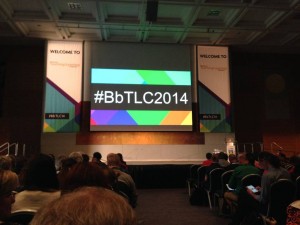Blackboard Teaching and Learning Conference, Dublin 2014
I recently attended the Blackboard Teaching and Learning Conference, held at The University College of Dublin, in Ireland. The Conference took part over 4 days and consisted of a number of keynotes, sessions and practical workshops from leading practitioners in E-Learning.
 In this blog post, I will share some elements of good practice, demonstrated at the conference and explain how you can use these approaches in your teaching.
In this blog post, I will share some elements of good practice, demonstrated at the conference and explain how you can use these approaches in your teaching.
You may have heard about the concept of the “flipped classroom”, but what does this term actually mean? In this post I will explain how other universities are using the idea of the flipped classroom to enhance their teaching and learning?
The Flipped Classroom
The flipped classroom is a form of blended learning in which students learn new content online by watching video lectures, usually at home, and what used to be homework is now done in class with teachers offering more personalised guidance and interaction with students, instead of lecturing.
The following information was mainly devised from Dan Hewes’ workshop ‘Flip Your Class with Blackboard Learn’. However there were a number of other talks that I attended during the conference that touched upon the idea of the flipped classroom and I have incorporated those ideas into this post.
So how does the flipped classroom work and how can you “flip” your classroom?
1. Firstly, ask yourself do I currently use class time to teach any low-level concepts? This does not mean simple content or of low-importance, but rather concepts that can be taught with little or no input from students.
2. If yes, create opportunities for students to obtain this information from outside the classroom. This is usually achieved by recording your lecture and uploading it to Blackboard for students to watch before the next face to face session. You may choose to record yourself delivering a lecture, or create an audio recording of your voice over of a powerpoint presentation.
3. To test that students have watched the lecture materials and understand the concepts being taught, you can create short tests and quizzes in Blackboard. A good approach is to create 3 questions for each lecture, 2 of which have clear, factual responses directly related to the lecture content and the final question is a little more challenging to test how well your students grasp the concept as a whole. You may also want to encourage your students to prepare questions for anything that they may not understand. This allows you to use the class time to address common problems, discuss the taught materials and facilitate group discussions.
4. In the classroom, have students work on group activities that encourage them to question theories and concepts and apply this knowledge in interactive activities.
5. As a module tutor, you can use this time to drop in and out of group sessions and monitor student engagement to check that they understand the topic.
Ok, I’m Ready to ‘Flip my Classroom’, but What Tools do I Need?
To ‘flip’ your classroom, you essentially need a way of allowing your students to obtain the information traditionally taught in the classroom, outside of the classroom.
Blackboard will be your central hub for storing all of your learning materials, managing assignments and assessments but in addition you will need a way of capturing your (otherwise taught face-to-face) materials, so students can view your lectures online.
The Use of Webcasts and Screencasts in Higher Education
In the majority of of sessions that I attended at the conference including Aarhus University – Denmark, Trinity College – Dublin and Northampton University, the use of lecture recordings and screencasts featured heavily.
Firstly, I’ll clarify the difference between a lecture recording and a screencast.
A webcast refers to the process of broadcasting a lecture or seminar over the internet. Webcasts may be streamed live or uploaded to Blackboard and viewed on demand.
Example webcast (lecture recording)
A screencast is a digital recording of computer screen output, also known as a video screen capture, often containing audio narration. In higher education, screencasts often take the form of a video recording of a Powerpoint presentation with voice over narration.
Example screencast
There are a number of software applications available that allow you to create a screencast. Camtasia and Screenr are two of the more popular programmes currently available. In addition to the screen capture software, you will also need a microphone that can be connected to a computer, or a computer with a built in microphone.
Recording a webcast requires a little more work to set up. The main difference being the need for a video camera to capture lectures in high definition. Many large lecture theatres now include the equipment to record lectures, but usually need the support of an audio visual team.
I hope that you’ve found this post useful. I will be posting another follow up to the Blackboard conference next week focused around the use of blogs, wiki’s and discussion forums in higher education.
